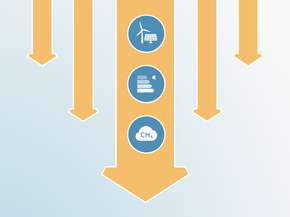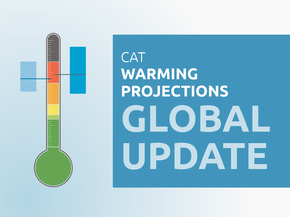Critically Insufficient4°C+
World
NDCs with this rating fall well outside of a country’s “fair share” range and are not at all consistent with holding warming to below 2°C let alone with the Paris Agreement’s stronger 1.5°C limit. If all government NDCs were in this range, warming would exceed 4°C.
Highly insufficient< 4°C
World
NDCs with this rating fall outside of a country’s “fair share” range and are not at all consistent with holding warming to below 2°C let alone with the Paris Agreement’s stronger 1.5°C limit. If all government NDCs were in this range, warming would reach between 3°C and 4°C.
Insufficient< 3°C
World
NDCs with this rating are in the least stringent part of a country’s “fair share” range and not consistent with holding warming below 2°C let alone with the Paris Agreement’s stronger 1.5°C limit. If all government NDCs were in this range, warming would reach over 2°C and up to 3°C.
2°C Compatible< 2°C
World
NDCs with this rating are consistent with the 2009 Copenhagen 2°C goal and therefore fall within a country’s “fair share” range, but are not fully consistent with the Paris Agreement long term temperature goal. If all government NDCs were in this range, warming could be held below, but not well below, 2°C and still be too high to be consistent with the Paris Agreement 1.5°C limit.
1.5°C Paris Agreement Compatible< 1.5°C
World
This rating indicates that a government’s NDCs in the most stringent part of its “fair share” range: it is consistent with the Paris Agreement’s 1.5°C limit.
Role model<< 1.5°C
World
This rating indicates that a government’s NDC is more ambitious than what is considered a “fair” contribution: it is more than consistent with the Paris Agreement’s 1.5°C limit.
Sources
List of references
- BP Energy Economics. (2018). BP Energy Outlook: 2018 Edition. Retrieved from https://www.bp.com/content/dam/bp/en/corporate/pdf/energy-economics/energy-outlook/bp-energy-outlook-2018.pdf
- Bridge to India. (2017). INDIA SOLAR HANDBOOK 2017. New Dehli. Retrieved from http://www.bridgetoindia.com/wp-content/uploads/2017/05/BRIDGE-TO-INDIA_India-Solar-Handbook_2017-1.pdf
- Central Electricity Authority. (2016). Draft Electricity Plan (Vol. 1). Retrieved from http://www.cea.nic.in/reports/committee/nep/nep_dec.pdf
- Coal India. (2018). Coal Vision 2030: Stakeholders’ Consultation. Retrieved from https://www.coalindia.in/DesktopModules/DocumentList/documents/Coal_Vision_2030_document_for_Coal_Sector_Stakeholders_Consultation_27012018.pdf
- EDF, CDC Climat Research, & IETA. (2015). India: An Emissions Trading Case Study. Retrieved from https://ieta.memberclicks.net/assets/CaseStudy2015/india_case_study_may2015.pdf
- EndCoal. (2017). Coal Plants by Country (MW). Retrieved from https://endcoal.org/wp-content/uploads/2017/07/PDFs-for-GCPT-July-2017-Countries-MW.pdf
- Forum of Regulators. (2014). Strategy for Providing 24x7 Power Supply. Retrieved from http://www.forumofregulators.gov.in/Data/WhatsNew/24x7.pdf
- Ganguly, A. (2018, January 23). All Talk, No Power: India’s Electricity Act is getting in the way of its grand electric-car plan. Quartz India. Retrieved from https://qz.com/1185278/indias-electricity-act-is-getting-in-the-way-of-its-grand-electric-car-plan/
- Gordon-Harper, G. (2018). Clean Energy Powers Sustainable Cities as Fossil Fuel Companies Predict Further Growth in Renewables. Retrieved from http://sdg.iisd.org/news/clean-energy-powers-sustainable-cities-as-fossil-fuel-companies-predict-further-growth-in-renewables/
- Government of India. (2012). India Second National Communication to the United Nations Framework Convention on Climate Change. Retrieved from http://unfccc.int/resource/docs/natc/indnc2.pdf
- Government of India. (2013). Twelfth Five Year Plan (2012–2017) Faster, More Inclusive and Sustainable Growth (Vol. I). Retrieved from http://planningcommission.nic.in/plans/planrel/fiveyr/12th/pdf/12fyp_vol1.pdf
- Government of India. (2015a). First Biennial Update Report to the United Nations Framework Convention on Climate Change. Ministry of Environment, Forest and Climate Change, Government of India. Retrieved from http://unfccc.int/resource/docs/natc/indbur1.pdf
- Government of India. (2015b). INDIA ’ S INTENDED NATIONALLY DETERMINED CONTRIBUTION :WORKING TOWARDS CLIMATE JUSTICE. Retrieved from http://www4.unfccc.int/submissions/INDC/Published Documents/India/1/INDIA INDC TO UNFCCC.pdf
- Government of India. (2016). Presentation on Perform , Achieve and Trade ( PAT ) Scheme. Retrieved from https://www.iea.org/media/training/eetw2016/industry/Mr.HanumantharayappaPresentationonPerformAchieveandTradePATScheme.pdf
- Government of India. (2018). Draft National Forest Policy, 2018. Retrieved from http://www.indiaenvironmentportal.org.in/files/file/Draft National Forest Policy, 2018.pdf
- IEA. (2016). World Energy Outlook 2016. International Energy Agency. Paris.
- IEA. (2017a). World Energy Outlook 2017. Paris, France: International Energy Agency. Retrieved from https://www.iea.org/weo2017/
- IEA. (2017b). World Energy Statistics and Balances. 2017 Edition. Paris, France, France: International Energy Agency.
- IEA. (2018). India: Indicators for 2015. Retrieved from https://www.iea.org/statistics/statisticssearch/report/?country=INDIA&product=indicators&year=2015
- IEA, & WBCSD. (2013). Technology Roadmap Low-Carbon Technology for the Indian Cement Industry.
- IEEFA. (2015). India’s Electricity-Sector Transformation. Retrieved from http://ieefa.org/wp-content/uploads/2015/08/IEEFA-Indian-Electricity-Sector-Transformation-11-August-2015.pdf
- Kenning, T. (2015). New India renewable targets put country on path to 69GW of PV by 2019. Retrieved September 1, 2015, from http://www.pv-tech.org/news/india_ramps_up_renewable_purchase_obligations_target
- Mathiesen, K. (2016). INDIA HALTS NEW COAL PLANTS AFTER 2022, LEAVES 178 GW ON THE DRAWING BOARDS. Retrieved September 4, 2017, from http://theenergymix.com/2016/12/19/india-halts-new-coal-plants-after-2022-leaves-178-gw-on-the-drawing-boards/
- MNRE. (2010). Jawaharlal Nehru National Solar Mission.
- MNRE. (2015). New Solar Energy Policy. Retrieved September 1, 2015, from http://pib.nic.in/newsite/pmreleases.aspx?mincode=28
- NITI Aayog. (2017a). Draft National Energy Policy.
- NITI Aayog. (2017b). India Three Year Aciton Agenda.
- Scroll.in. (2017). Climate change: India begins work on meeting its obligations under the Paris Agreement. Retrieved September 4, 2017, from https://scroll.in/article/843416/climate-change-india-begins-work-on-meeting-its-obligations-under-the-paris-agreement
- The Energy and Resources Institute. (2017). Transitions in the Indian Energy Sector -Macro Level Analysis of Demand and Supply Side Options. Retrieved from http://www.teriin.org/files/transition-report/files/downloads/Transitions-in-Indian-Electricity-Sector_Report.pdf
- The International Council on Clean Transportation. (2014). FACT SHETT INDIA: LIGHT-DUTY VEHICLE EFFICIENCY STANDARDS. Retrieved from http://www.theicct.org/sites/default/files/info-tools/pvstds/India_PVstds-facts_dec2014.pdf
- Transportpolicy.net. (2017). India: Light-duty: Fuel Consumption.
- UNFCCC. (2016). GHG Profiles - Non-Annex I. Retrieved September 4, 2017, from http://di.unfccc.int/ghg_profile_non_annex1
- US EPA. (2012). Global Anthropogenic Non-CO2 Greenhouse Gas Emissions: 1990 - 2030. Retrieved from http://www.epa.gov/climatechange/Downloads/EPAactivities/EPA_Global_NonCO2_Projections_Dec2012.pdf
- World Bank. (2017). CO2 emissions (metric tons per capita). Retrieved from https://data.worldbank.org/indicator/EN.ATM.CO2E.PC
Further analysis
Latest publications
Stay informed
Subscribe to our newsletter




